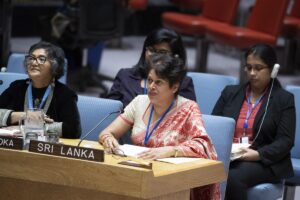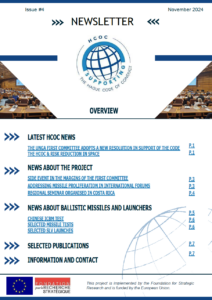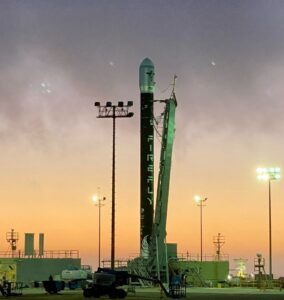Harnessing Transparency Potential
For Missile Non-Proliferation
HCOC RESEARCH PAPERS NO. 9
Information is key for non-proliferation efforts. But the times when information was the exclusive purview of governments are over.
Affordable, commercial and open-source monitoring capabilities empower states and societies alike, while
challenging the ability of governments to preserve secrecy. Technological democratisation means that information is practically becoming a public good. And it allows for unprecedented transparency.
This paper explores how transparency affects missile-related activities, how growing access to technologies increases transparency and what further opportunities and challenges it creates for HCoC.
DECEMBER 2021
Katarzyna Kubiak
Room for Manoeuvre
“143 HCoC signatories have committed to a set of rules. They accept that benefiting from space should not lead to proliferation, and that transparency on ballistic missiles and space launch vehicles should generate trust in other actors’ intentions.”
One way to slow down the proliferation of weapons of mass destruction (WMDs) is by restraining their means of delivery, such as missiles, rockets or drones. Ballistic missiles remain the most prominent means of transporting WMDs because of their speed and reach. In the past 50 years, Soviet Scud missile technology has spread to at least 13 countries and several non- state actors, and the trend is growing.1 Hindering indigenous development as well as access to entire delivery systems and to the knowledge, technology and resources necessary to develop and produce them can prevent or decelerate the spread of missile technology.2
To ensure that states neither covertly develop nor expand their missile arsenals, some of them apply voluntary transparency measures. This promotes mutual trust. They do so through the Hague Code of Conduct (HCoC), a political missile control instrument setting norms for missile-related transparency.
143 HCoC signatories have committed to a set of rules. They accept that benefiting from space should not lead to proliferation, and that transparency on ballistic missiles and space launch vehicles should generate trust in other actors’ intentions. States pledge to curb proliferation domestically and internationally. To assure fellow signatories that they are abiding by these rules and to avoid any misunderstanding, they shall inform others ahead of a ballistic missile or space launch vehicle launch (pre-launch notifications) and submit an annual declaration on their ballistic missile and space launch activities.
But their commitment goes well beyond these well-defined tangible deliverables. HCoC also encourages state parties to pursue its goals by international, multilateral, bilateral and national endeavours and to engage in cooperative although not explicitly specified measures among themselves.
Given the changing international technological and political environment, the HCoC requires constant adaptation to keep up to speed. Yet because modernising such a regime is a sensitive and lengthy political process,3 member states might be interested in looking for additional avenues to live up to their commitments. This article explores how HCoC signatories could harness technology -enabled transparency as one way of using its room for manoeuvre. […]
1 Xu Tianran and Melissa Hanham, ‘The Next 50 Years of Missile Proliferation,’ Open Nuclear Network, 15 February 2021, https://www.oneearthfuture.org/file/1834/download?token=1fOY_Mks.
2 Jürgen Scheffran, ‘Dual Use of Missiles and SpaceTechnologies,’ in Götz Neuneck and Otfried Ischebeck (eds.), Missile Proliferation, Missile Defense, and Arms Control, Nomos, January 1993, pp. 49-68.
3 Nikolai Sokov, ‘The Hague Code of Conduct: Multivector Expansion,’ Middlebury Institute of International Studies at Monterey, 10 October 2019, https://nonproliferation.org/the-hague-code-of-conduct-multivector-expansion/.



